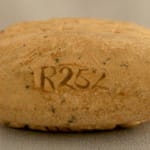Terracotta Cuneiform Tablet, 2250 BCE - 2000 BCE
Terracotta
1.25 x 1.5 x 0.625
CK.0182
Further images
The oldest known written language, cuneiform, first used by the ancient peoples of the Near East over 5000 years ago, is composed of a series of wedge-shaped incisions made with...
The oldest known written language, cuneiform, first used by the ancient peoples of the Near East over 5000 years ago, is composed of a series of wedge-shaped incisions made with a sharpened reed stylus. This script was adopted by all the major civilizations of Mesopotamia for recording their distinct languages, including the Sumerians, Akkadians, Assyrians, and Babylonians. Clay tablets were the preferred media for everyday writing because they could either be easily recycled or, if a permanent record was required, fired in a kiln and preserved. The earliest recorded inscriptions are not myths of histories, but rather banal economic transactions and accounting documents. Later, one of the most famous written works of the ancient world, Hammurabi’s code, was recorded in the cuneiform script. While these marks may appear obscure and mysterious to our eyes, scholars have made much progress in deciphering cuneiform after discovering inscriptions on the Behistun Rock, a cliff in western Iran. Much like the Rosetta Stone, the Behistun Inscription contained the same text written in three different languages (Persian, Babylonian, and Elamite), all of which utilized the cuneiform system of writing. Due to the resemblance of these languages to modern ones, scholars were able to crack to code.
This small clay tablet has been inscribed with cuneiform text covering both front and back, as well as one of the sides and a portion of the top. The bottom features and old inventory tag from an unknown collection reading "R252".
This small clay tablet has been inscribed with cuneiform text covering both front and back, as well as one of the sides and a portion of the top. The bottom features and old inventory tag from an unknown collection reading "R252".





